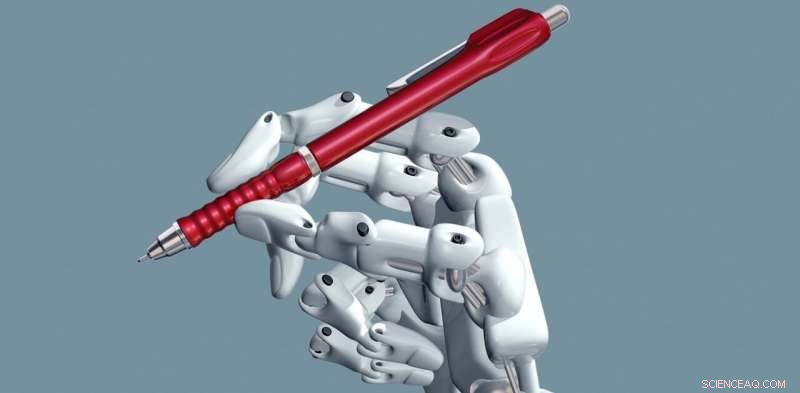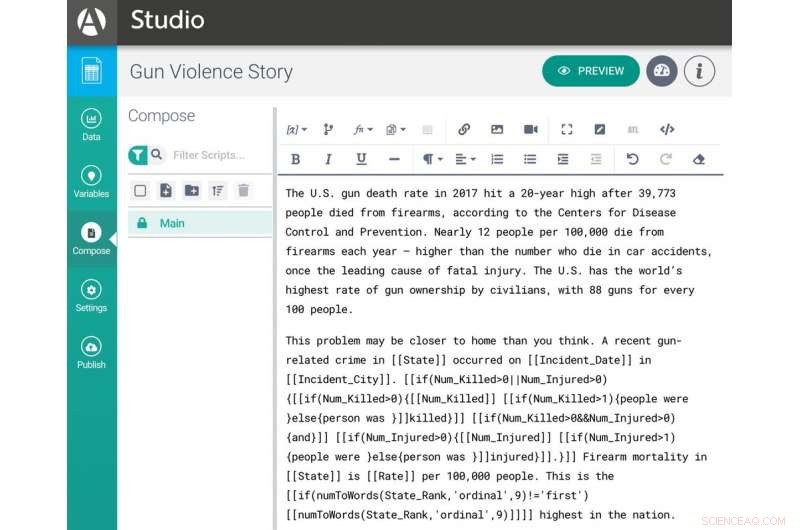
I robot non reggeranno ancora le penne, ma possono aiutare le persone a fare il lavoro. Credito:Paul Fleet/Shutterstock.com
Proprio come i robot hanno trasformato intere aree dell'economia manifatturiera, l'intelligenza artificiale e l'automazione stanno cambiando il lavoro dell'informazione, lasciare che gli umani scarichino il lavoro cognitivo sui computer. Nel giornalismo, ad esempio, i sistemi di data mining avvisano i giornalisti di potenziali notizie, mentre i newsbot offrono nuovi modi per il pubblico di esplorare le informazioni. I sistemi di scrittura automatizzati generano risorse finanziarie, copertura sportiva ed elettorale.
Una domanda comune quando queste tecnologie intelligenti si infiltrano in vari settori è come il lavoro e la manodopera saranno interessati. In questo caso, chi o cosa farà giornalismo in questo mondo automatizzato e potenziato dall'intelligenza artificiale, e come lo faranno?
Le prove che ho raccolto nel mio nuovo libro "Automating the New:How Algorithms are Rewriting the Media" suggeriscono che il futuro del giornalismo basato sull'intelligenza artificiale avrà ancora molte persone intorno. Però, i lavori, ruoli e compiti di queste persone si evolveranno e appariranno un po' diversi. Il lavoro umano sarà ibridato, combinato con algoritmi, per adattarsi alle capacità dell'IA e soddisfare i suoi limiti.
aumentare, non sostituendo
Alcune stime suggeriscono che gli attuali livelli di tecnologia AI potrebbero automatizzare solo il 15% circa del lavoro di un giornalista e il 9% del lavoro di un editore. Gli esseri umani hanno ancora un vantaggio sull'intelligenza artificiale non hollywoodiana in diverse aree chiave che sono essenziali per il giornalismo, compresa la comunicazione complessa, pensiero esperto, adattabilità e creatività.
Segnalazione, ascoltando, rispondendo e respingendo, negoziare con le fonti, e poi avere la creatività per metterlo insieme:l'intelligenza artificiale non può svolgere nessuno di questi compiti giornalistici indispensabili. Può spesso aumentare il lavoro umano, anche se, per aiutare le persone a lavorare più velocemente o con una migliore qualità. E può creare nuove opportunità per approfondire la copertura delle notizie e renderla più personalizzata per un singolo lettore o spettatore.
Il lavoro in redazione si è sempre adattato alle ondate di nuove tecnologie, compresa la fotografia, telefoni, computer, o anche solo la fotocopiatrice. I giornalisti si adatteranno per lavorare con l'IA, pure. Come tecnologia, è già e continuerà a cambiare le notizie, spesso integrando ma raramente sostituendosi a un giornalista esperto.
Nuovo lavoro
Ho scoperto che il più delle volte, Le tecnologie AI sembrano effettivamente creare nuovi tipi di lavoro nel giornalismo.
Prendiamo ad esempio l'Associated Press, che nel 2017 ha introdotto l'uso delle tecniche di computer vision AI per etichettare le migliaia di foto di cronaca che gestisce ogni giorno. Il sistema può taggare le foto con informazioni su cosa o chi c'è in un'immagine, il suo stile fotografico, e se un'immagine rappresenta una violenza grafica.
Il sistema offre agli editor di foto più tempo per pensare a ciò che dovrebbero pubblicare e li libera dal passare molto tempo solo a etichettare ciò che hanno. Ma svilupparlo ha richiesto un sacco di lavoro, sia editoriale che tecnico:i redattori dovevano capire cosa taggare e se gli algoritmi erano all'altezza del compito, quindi sviluppare nuovi set di dati di test per valutare le prestazioni. Quando tutto ciò è stato fatto, dovevano ancora supervisionare il sistema, approvando manualmente i tag suggeriti per ogni immagine per garantire un'elevata precisione.

L'interfaccia utente di Arria Studio che mostra la composizione di una storia personalizzata sulla violenza armata. Credito:Nicholas Diakopoulos screenshot di Arria Studio, CC BY-ND
Stuart Myles, l'esecutivo AP che sovrintende al progetto, mi ha detto che ci sono voluti circa 36 mesi-persona di lavoro, diffuso in un paio d'anni e più di una dozzina di editoriali, technical and administrative staff. About a third of the work, he told me, involved journalistic expertise and judgment that is especially hard to automate. While some of the human supervision may be reduced in the future, he thinks that people will still need to do ongoing editorial work as the system evolves and expands.
Semi-automated content production
In the United Kingdom, the RADAR project semi-automatically pumps out around 8, 000 localized news articles per month. The system relies on a stable of six journalists who find government data sets tabulated by geographic area, identify interesting and newsworthy angles, and then develop those ideas into data-driven templates. The templates encode how to automatically tailor bits of the text to the geographic locations identified in the data. Ad esempio, a story could talk about aging populations across Britain, and show readers in Luton how their community is changing, with different localized statistics for Bristol. The stories then go out by wire service to local media who choose which to publish.
The approach marries journalists and automation into an effective and productive process. The journalists use their expertise and communication skills to lay out options for storylines the data might follow. They also talk to sources to gather national context, and write the template. The automation then acts as a production assistant, adapting the text for different locations.
RADAR journalists use a tool called Arria Studio, which offers a glimpse of what writing automated content looks like in practice. It's really just a more complex interface for word processing. The author writes fragments of text controlled by data-driven if-then-else rules. Ad esempio, in an earthquake report you might want a different adjective to talk about a quake that is magnitude 8 than one that is magnitude 3. So you'd have a rule like, IF magnitude> 7 THEN text ="strong earthquake, " ELSE IF magnitude <4 THEN text ="minor earthquake." Tools like Arria also contain linguistic functionality to automatically conjugate verbs or decline nouns, making it easier to work with bits of text that need to change based on data.
Authoring interfaces like Arria allow people to do what they're good at:logically structuring compelling storylines and crafting creative, nonrepetitive text. But they also require some new ways of thinking about writing. Ad esempio, template writers need to approach a story with an understanding of what the available data could say—to imagine how the data could give rise to different angles and stories, and delineate the logic to drive those variations.
Supervision, management or what journalists might call "editing" of automated content systems are also increasingly occupying people in the newsroom. Maintaining quality and accuracy is of the utmost concern in journalism.
RADAR has developed a three-stage quality assurance process. Primo, a journalist will read a sample of all of the articles produced. Then another journalist traces claims in the story back to their original data source. As a third check, an editor will go through the logic of the template to try to spot any errors or omissions. It's almost like the work a team of software engineers might do in debugging a script—and it's all work humans must do, to ensure the automation is doing its job accurately.
Developing human resources
Initiatives like those at the Associated Press and at RADAR demonstrate that AI and automation are far from destroying jobs in journalism. They're creating new work—as well as changing existing jobs. The journalists of tomorrow will need to be trained to design, update, tweak, validate, correct, supervise and generally maintain these systems. Many may need skills for working with data and formal logical thinking to act on that data. Fluency with the basics of computer programming wouldn't hurt either.
As these new jobs evolve, it will be important to ensure they're good jobs—that people don't just become cogs in a much larger machine process. Managers and designers of this new hybrid labor will need to consider the human concerns of autonomy, effectiveness and usability. But I'm optimistic that focusing on the human experience in these systems will allow journalists to flourish, and society to reap the rewards of speed, breadth of coverage and increased quality that AI and automation can offer.
Questo articolo è stato ripubblicato da The Conversation con una licenza Creative Commons. Leggi l'articolo originale. 